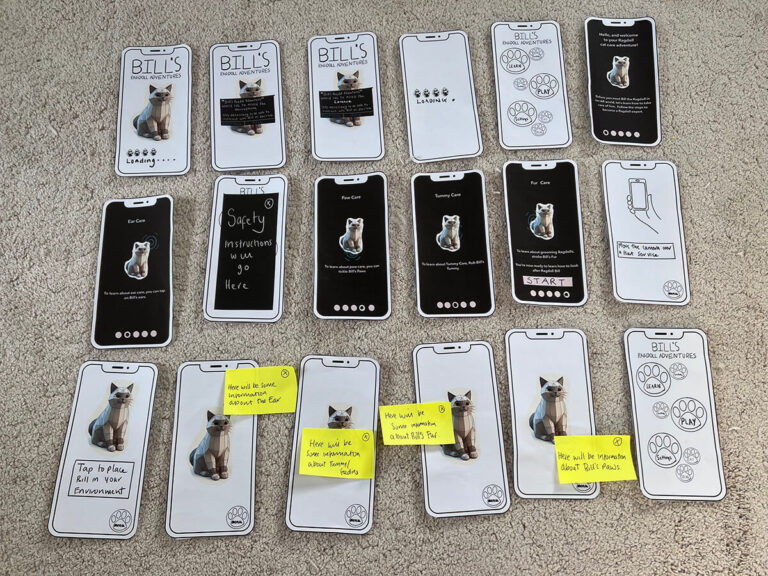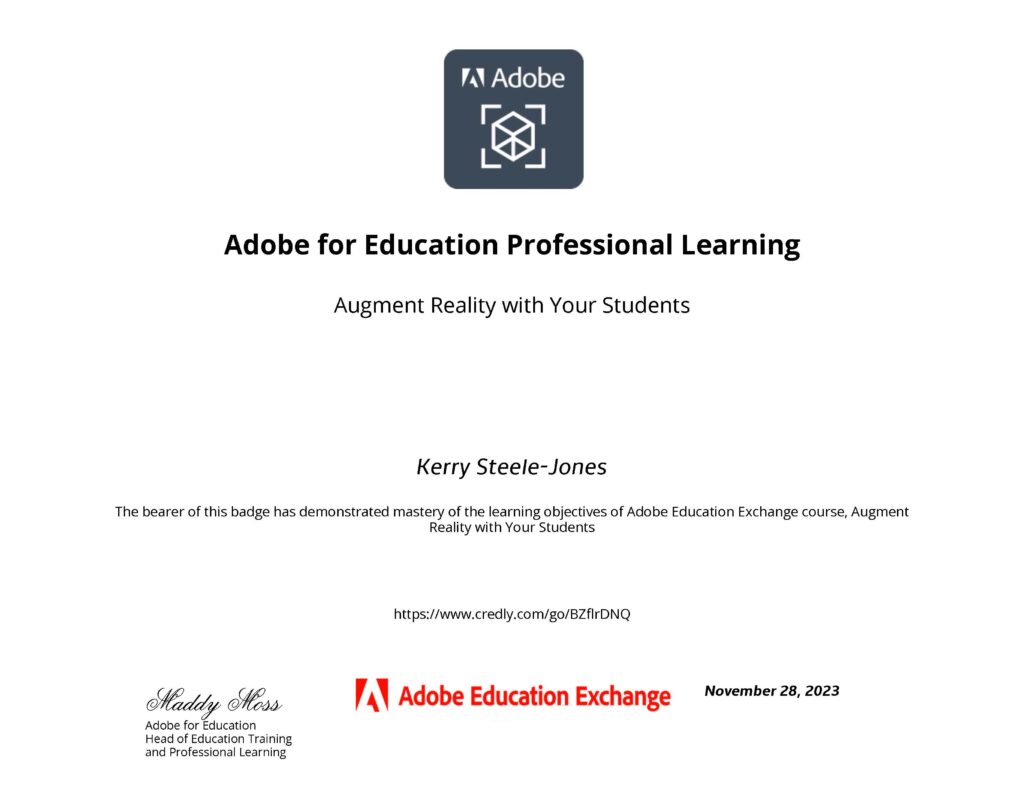OBJECTIVE: Apply human-centered design principles by developing thorough documentation that outlines your vision for the application. This documentation will serve as a roadmap for the subsequent prototyping phase, ensuring that the XR experience is user-centric and technologically sound
The Extended Reality [XR] Exploration Hub is an project that guides users through the realms of augmented reality (AR), virtual reality (VR), and mixed reality (MR) within a virtual reality setting. Through a series of captivating mini-worlds, this interactive experience offers a hands-on introduction to the exciting possibilities of XR technology.
This portfolio page provides detailed documentation on the XR Exploration Hub project, including its conception, design, and implementation. It includes user personas, sketches, and design artifacts.
Initial Project Ideation
Evolution of VR Concept: From Academic Module Support to Immersive XR Exploration:
Originally conceived as a resource for an MA Digital Media module titled ‘Emerging Media’, the XR Exploration Hub aimed to introduce students to the diverse world of emerging technologies, including augmented reality (AR), virtual reality (VR), mixed reality (MR), apps, and website interactions.
The project was structured around interconnected ‘mini-worlds’, each highlighting different aspects of XR technology and its applications in various sectors. However, upon reflection, several changes have been made to refine the project’s scope and focus.
The project’s structure has been streamlined to focus solely on XR technologies (AR, VR, MR), excluding web and app interactions. This adjustment aimed to simplify the project’s objectives and make it more accessible to a broader audience beyond MA students, introducing XR technologies to students and staff across different disciplines within the faculty and to those outside of the university.
Click on the Miro board to view the initial project ideas and reflections.
Seven Questions Before Prototyping & Project Brief
Seven Questions:
The Seven Questions Before Prototyping (Zubek, 2020) document outlines crucial considerations for designing the XR Exploration Hub. It delves into defining the user’s goal, outlining the inputs required for interaction, and emphasising the extensibility of activities to sustain user engagement. Additionally, it highlights the importance of offering diverse resource types and adhering to a defining rule to ensure a cohesive and impactful experience. The document underscores the significance of assessing users’ understanding and engagement with immersive technologies. Ultimately, it provides a structured framework for designing an immersive and educational XR experience that captivates users and fosters learning.
Project Brief
The XR Exploration Hub is an immersive project designed to introduce users to the principles, tools, and techniques of emerging technologies such as augmented reality (AR), virtual reality (VR), and mixed reality (MR). Serving as a VR onboarding tool, the project aims to help novices become familiar with VR environments and controls before delving into other VR applications or experiences. Targeting a diverse audience, including novice technology users, students interested in XR, faculty staff, and workshop attendees new to immersive technologies, the XR Exploration Hub offers interactive ‘mini-worlds’ where users can navigate, interact, and learn about the functionalities of AR, VR, and MR technologies. Through intuitive gestures and button presses using VR controllers, users will gain hands-on experience and insights into the applications of these technologies across various domains.
Click on the Miro board to view the Seven Questions & Project Brief Documents
User Personas
Creation of User Personas and Insights from Workshops for Designing a Tailored VR Experience
Audience Research:
The user personas were crafted through workshops conducted during various events, including applicant open days for potential students, a well-being conference for NHS staff, and VR training sessions for faculty staff.
Understanding Our Users:
These workshops gave valuable insights into our target audience’s preferences, needs, and behaviours. Each persona represents a distinct user profile with specific interests, goals, and challenges related to VR technology.
Creation of user Personas
During the workshops, insights were gathered about three distinct user personas: the Fashion Marketing Student attending an Applicant Open Workshop, the NHS Staff Member participating in a Well-being Conference, and the University Lecturer attending a Faculty Training Day. The Fashion Marketing Student, a 22-year-old passionate about creativity and fashion, seeks to explore VR technology’s potential applications in the fashion industry. The NHS Staff Member, a 35-year-old dedicated to promoting mental health, is interested in innovative approaches to well-being and sees VR as a tool for mental health interventions. Meanwhile, the University Lecturer, aged 45, aims to enhance teaching practices through technology, viewing VR as a means to improve student engagement and learning outcomes. These personas collectively provide valuable insights into our target audience’s preferences, needs, and motivations, guiding the development of a tailored VR hub experience focused on immersive technology integration.
Reflection
The key observation from the workshops was the significant time it took for participants to get acquainted with the VR authoring tools and navigate to the designated virtual room. This onboarding process proved particularly challenging for those less familiar with the technology, highlighting the need for a more seamless and user-friendly experience. As a response, the XR Hub I aim to create will serve as an introductory platform for VR, providing users with an intuitive environment to familiarise themselves with controls and interactions. However, for more advanced users adept at VR navigation, the platform will offer immersive content tailored to their interests and industry applications. This dual-purpose approach aims to streamline the onboarding process for newcomers while catering to the diverse needs and preferences of experienced users.
Additionally, ‘The VR Hub’ has been reimagined to prioritise mental well-being, inspired by insights from workshops, particularly Dr. Patel’s aspirations. Drawing from the PERMA model, it aims to promote Positive Emotions, Engagement, Relationships, Meaning, and Accomplishment. While initially centred on Dr Patel’s interests, the experience will also showcase immersive content relevant to other personas, illustrating the versatility of VR technology across various industries. The experience becomes universally applicable by focusing on well-being, reflecting a deeper understanding of users’ desires for technology that enhances overall wellness.
Click on the Miro board to view the User Personas
Design Exploration and Scenario Development
Moodboard
Following insights from the user personas, the next step involved mood boarding to understand interactions, locomotion, and feedback mechanisms while exploring the aesthetic style, mainly focusing on low-poly art. This research informed the project and has provided a valuable resource for future endeavours, ensuring that functional and stylistic aspects align with user preferences and project goals.
During this phase, various interaction types were explored, including object manipulation, gesture-based interactions, and social interactions. Feedback mechanisms such as visual, auditory, and haptic feedback were also considered to enhance user engagement and immersion within the virtual environment.
Click on the Miro board to view the moodboard
Scenarios
Three distinct scenarios have been crafted [for the VR hub], each with its own narrative and interaction flow. While the primary focus will be on sketching visuals for the bridge-building exercise [for this week’s assignment], the aim is to develop all three scenarios for the final project [time permitting].
Enchanted Bridge Scenario
Users embark on a journey through a forest, where they encounter a broken bridge. Through interactive prompts and on-screen guidance, users learn VR controls while repairing the bridge by placing scattered pieces in designated positions. This scenario focuses on object manipulation and locomotion, providing a tutorial for VR novices and an immersive experience for advanced users.
Butterfly Kaleidoscope Scenario
Users find themselves surrounded by a display of butterflies. Through hand gestures interactions, users can interact with the butterflies, causing them to flutter and dance around them. This scenario emphasises gesture-based interactions and visual feedback, creating a calming and immersive experience.
Wisdom of the Owl Scenario
Users encounter a wise owl perched on a branch, eager to impart knowledge. Through conversational interactions using voice commands or via a user interface, users engage with the owl and answer questions to unlock hidden wisdom. This scenario focuses on social interactions and gameplay, providing users a sense of connection and discovery.
For each scenario, interaction flows have been created to guide and assist with the sketch prototyping.
To help visualize the project, DALL-E created concept art in the preferred low-poly art style. This art serves as a visual representation of the envisioned XR Hub experience, enhancing clarity and guiding development efforts. The concept art provides a tangible reference for each scenario’s intended aesthetic and atmosphere, ensuring alignment with project goals and user expectations.
Click on the Miro board to view the VR Hub Scenarios
Storyboarding
After creating scenario scripts and interaction flows, low-fidelity storyboards were developed to provide visual guidance and depict the sequence of interactions and user experiences envisioned for each scenario [of the enchanted bridge]. The next step will involve creating detailed pattern interactions for various scenes, such as building the bridge, to further refine the XR Hub experience.
A valuable resource to assist with this is the Unity Forum, which discusses the “VR Interaction Framework” released by BeardedNinjaGames (BeardedNinjaGames, 2020). This framework offers features designed to simplify the creation of interactable objects in VR, including physical grabbing, throwing, teleportation, two-handed climbing, bow and arrow physics, gun handling, and more. This resource will be instrumental in implementing interactive elements within the XR Hub experience





